» SELECTED G∴D∴ PUBLICATIONS «
4°=7° Philosophus
THE FIFTH KNOWLEDGE LECTURE
To be studied in the Grade of Philosophus (4°=7°).
Aspirants will be tested on their knowledge of the following material, which must be committed to memory.
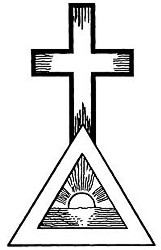
TABLE OF CONTENTS

The Philosophus Symbols
ADMISSION BADGES USED IN THE GRADE OF PHILOSOPHUS
△
The Calvary Cross of twelve squares
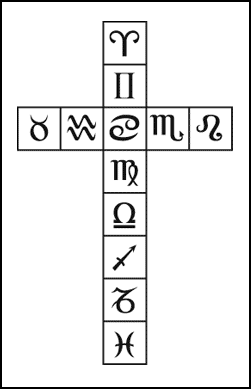
It admits to the path of Qoph כ, the 29th path, and refers to the Zodiac and to the eternal River of Eden, divided into four heads as follows:
NAHER - The River
1. Hiddikel
2. Pison
3. Gihon
4. Phrath - Euphrates
The Four Arms of the cross elucidate the ZODIAC which embraces the Waters of Nu, as the ancient Egyptians called the Heavens, the Waters which are above the Firmament. It also alludes to the Eternal River, divided into four streams which find their correlations in the four triplicities of the Zodiac.
Questions about the "Latin Cross of 12 Squares":
- To What Path is it Related? = The 29th Path of Qoph כ (The Moon).
△
The Calvary Cross of Ten Squares
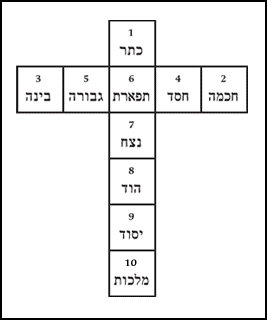
The next Badge is the Calvary Cross of ten squares admitting to the path of Peh פ, Mars, the 27th Path. The ten squares are referred to the Ten Sephiroth in balanced disposition. It is also the opened out form of the double cube of the Altar of incense.
Questions about the "Latin Cross of Ten Squares":
- To what path is it related? = The 27th Path of Peh פ (The Tower)
△
Hegemon’s Cross admitting to the Grade of Philosophus
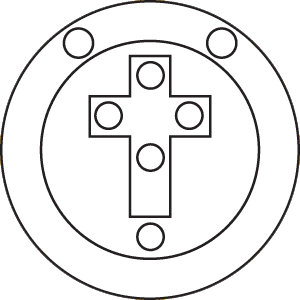
The Admission Badge for the Grade of Philosophus.
The cross embraces Tiphareth, Netzach, Hod, and Yesod, and rests upon Malkuth. The Latin Cross of Six Squares also refers to the six Sephiroth of Microprosopus and is the opened out form of the cube.
[ « back to TOC ]

The formation and significance of AZOTH
AZOTH is a word formed from the initial and final letters of the Greek, Latin, and Hebrew Alphabets thus: A and Z, Aleph and Tau, Alpha and Omega. It is used with various meanings by different writers but generally signifies Essence.
△
VEILS OF THE NEGATIVE EXISTENCE
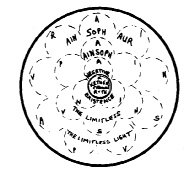
| Name — English Transliteration |
Name — Hebrew |
Meaning — English |
| Ain — the Negative |
 |
Nothing — Not |
| Ain Soph |
 |
Limitless |
| Ain Soph Aur |
 |
The Limitless Light |
These three are the Veils of negative existence behind as it where Kether.
△
THE TWO TITLES OF KETER
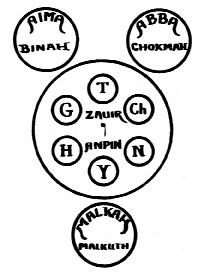
Arik Anpin - MACROPROSOPUS or the vast countenance is one of the titles of Kether, yet another of its titles is the Ancient of Days, Aatik Yomin. Kether or the vast countenance emanates first as Abba the supernal Father, and Aima, the supernal Mother. Abba is referred to Yod of YHVH, and Aima is referred to Heh of YHVH. Elohim is a name given to these two Hypostases united.
| Name — English Transliteration |
Name — Hebrew |
Greek |
Meaning—English |
| Arik Anpin |
 |
Macroprosopus |
The Vast Countenance |
| Aatik Yomin |
 |
— |
Ancient of Days |
As Elohim they are considered the parents of the Son, Zauir Anpin, also called MICROPROSOPUS, or the lesser countenance.
Abba is referred to Yod and Chokmah. Aima is referred to Heh and Binah. Zauir Anpin is referred to the 6 Sephiroth Chesed, Geburah, Tiphareth, Netzach, Hod, Yesod and of these especially to Tiphareth.
Malkah the queen and Kalah the bride are titles of Malkuth when considered as the spouse of Zauir Anpin, the Microprosopus.
△
TETRAGRAMMATON
Atributions of the Holy Name to the Four Worlds and the Four Suits
The letters of the name YHVH contain these meanings:
- Yod is referred to Abba.
- Heh to Aima.
- Vau to Zauir Anpin.
- Heh (1) to Malkah.
These letters are also referred to the four worlds and the four suits of the Tarot thus:
| OSOGD Holy Name |
Traditional Holy Name |
Qabalistic World |
Tarot Suit |
 |
 |
Atziluth |
Wands |
 |
 |
Briah |
Cups |
 |
 |
Yetzirah |
Swords |
 |
 |
Assiah |
Pentacles |
In each of the Four Worlds are the 10 Sephiroth of that World and each Sephirah has its own 10 Sephiroth making 400 in all. This signifies the number of Tau, the Cross, The Universe and the completion of all things. (The modern student may look at this and arrive at a different number for the total)
The four aces are placed on the Throne of Kether — the remaining small cards of the suit desired on the respective Sephiroth, two on Chokmah, three on Binah, etc. The 22 Trumps are arranged on the paths between them, according to the Letters to which they correspond. The King and Queen are placed beside Chokmah and Binah respectively, the Knight and Knave by Tiphareth and Malkuth. The Trumps thus receive the equilibrium of the Sephirot (spheres) they connect.
[ « back to TOC ]

The Four Elements
△
The Pyramid of the Four Elements
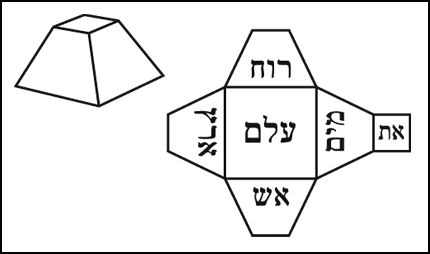
The Pyramid of the Four Elements admits to the path of Tzaddi צ, the 28th Path. On the sides of the pyramid are the Hebrew names of the elements. On the apex is the word ETH, meaning essence and on the base is the word OLAM, meaning world.
Questions about the "Pyramid of the Four Elements":
- To What Path is it related? = The 28th Path of Tzaddi צ (The Star).
Names connected to the Four Elements:
The names of each emanation, its attribution to the Tetragramaton, and the Sepherotic attributions.
| EARTH |
|
English Translation |
Hebrew |
| Hebrew Name |
Aretz |
 |
| Great Name |
Adonai Ha Aretz |
 |
| Cardinal Point |
North |
— |
| Archangel |
Auriel |
 |
| Elementals |
Gnomes |
— |
| AIR |
|
English Translation |
Hebrew |
| Hebrew Name |
Ruach |
 |
| Great Name |
Shaddai El Chai |
 |
| Cardinal Point |
East |
— |
| Archangel |
Raphael |
 |
| Elementals |
Sylphs |
— |
| WATER |
|
English Translation |
Hebrew |
| Hebrew Name |
Maim |
 |
| Great Name |
Elohim Tzabaoth |
 |
| Cardinal Point |
West |
— |
| Archangel |
Gabriel |
 |
| Elementals |
Undines |
— |
| FIRE |
|
English Translation |
Hebrew |
| Hebrew Name |
Asch |
 |
| Great Name |
Asherah Tzabaoth |
 |
| Cardinal Point |
South |
— |
| Archangel |
Michael |
 |
| Elementals |
Salamanders |
— |
[ « back to TOC ]

The Tree of Life
Other Arrangements of the Tree of Life
There are various formats of the Sephiroth. The most frequent has already been given, but there is another in common usage and will be seen to have been employed in some of the large Altar diagrams of both the Practicus and Philosophus Grade. It is often referred to as The Seven Palaces of Assiah attributed to the ten Sephiroth.
△
EMANATIONS OF KETHER
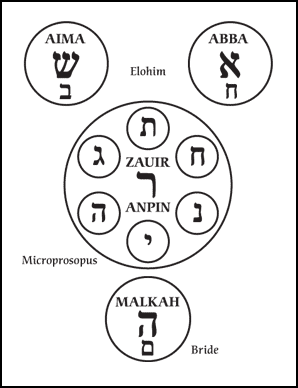
△
THE SEVEN PALACES
The Seven Palaces attributed to the Ten Sephiroth Diagram:
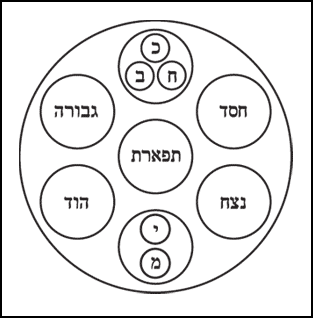
This drawing represents the triad of elements operating through the Sephiroth and reflected downwards into the Tree. Air is reflected straight down the Middle Pillar, from Kether through Tiphareth to Yesod and the upper quadrant of Malkuth. Water is relfected cross-wise from Binah through Chesed to Hod. Fire is reflected cross-wise from Chokmah through Geburah to Netzach. Malkuth therefore becomes the receptacle of the other three elements.
△
THE SYMBOL OF VENUS ON THE TREE OF LIFE
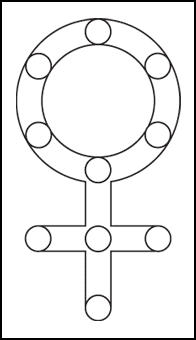
It embraces all ten Sephiroth on the Tree. It is a fitting emblem of the isis of Nature. Since it contains all the Sephiroth its circle should be made larger then that of Mercury shown in a previous diagram.
△
THE ALCHEMICAL SYMBOL OF SULPHUR ON THE TREE OF LIFE
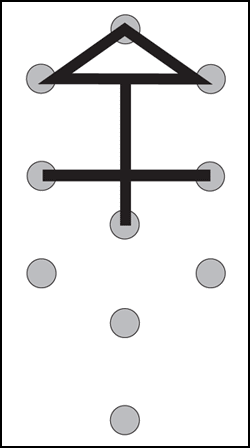
Questions about the "The Alchemical Symbol of Sulphur on the Tree of Life":
- What does Tiphareth represent in the preceding diagram? = The “Purified” man.
△
THE SYMBOL OF SALT ON THE TREE OF LIFE
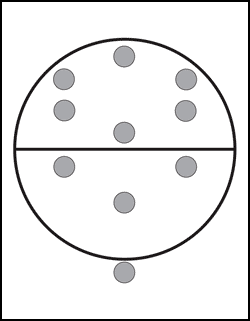 |
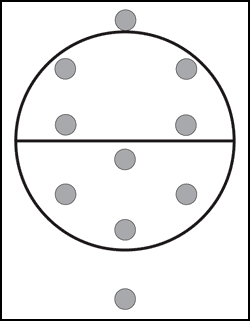 |
| Source: Regardie |
Source: Zalewski |
The horizontal line represents the precept of Hermes, “As above so below.”
Questions about the "Symbol of Salt on the Tree of Life":
- Explain the significance of the horizontal line.
△
THE REFLECTION OF THE ELEMENTS DOWN THE TREE
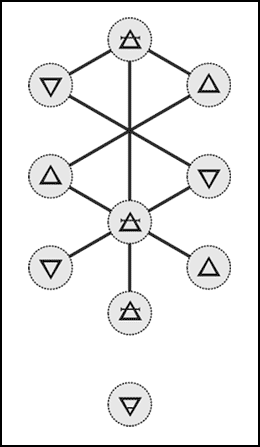 |
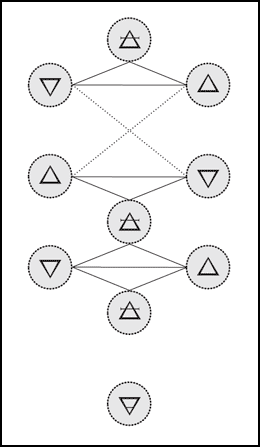 |
| Source: Regardie |
Source: Zalewski |
Two diagrams illustrating The Triad operating through the Sephiroth.
△
ALCHEMICAL ATTRIBUTIONS
Two further Alchemical Attributions to the Tree of Life:
|
Element Set One |
Element Set Two |
| 1 |
Mercury |
The Metallic Root |
| 2 |
Salt |
Lead |
| 3 |
Sulphur |
Tin |
| 4 |
Silver |
Silver |
| 5 |
Gold |
Gold |
| 6 |
Iron |
Iron |
| 7 |
Copper |
Hermaphroditical Brass |
| 8 |
Tin |
Brass |
| 9 |
Lead |
Mercury |
| 10 |
Mercury Philosophorum |
Medicina Metallorum |
△
THE QLIPPOTH
The Qlippoth of the Tree of Life:
|
Qlippothotic Sepheroth |
Meaning |
| 1 |
Thaumiel |
The two contending Forces |
| 2 |
Ghogiel |
The Hinderers |
| 3 |
Satariel |
The Concealers |
| 4 |
Agshekeloh |
The Breakers in Pieces |
| 5 |
Golohab |
The Burners |
| 6 |
Tagiriron |
The Disputers |
| 7 |
Gharab Tzerek |
The Ravens of Death |
| 8 |
Samael |
The Liar or Poison of God |
| 9 |
Gamaliel |
The Obscene Ones |
| 10 |
Lilith |
Queen of the Night and of Demons |
△
THE THREE PILLARS
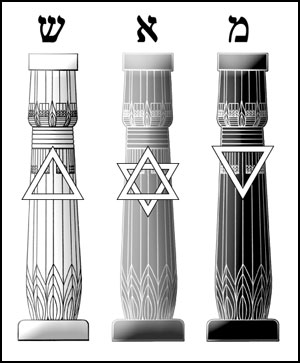
△
Attributions of the Pillars:
|
Black Pillar |
White Pillar |
| Direction |
North |
South |
| Viewed Side |
Left |
Right |
| Personal Side |
Right |
Left |
| Qaballistic Pillar |
Severity |
Mercy |
| Golden Dawn Office |
Stolistes |
Dadouchos |
| Masonic Name |
Boaz |
Jachin |
△
THE HEXAGRAM OF TIPHARETH ON THE TREE OF LIFE
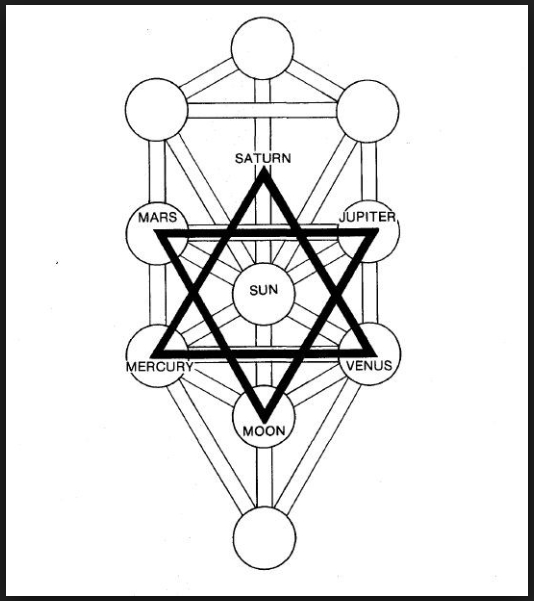
[ « back to TOC ]

Astrological Symbols
Deconstruction of Astrological Symbols of the Planets
into Cross, Crescent, & Triangle
|
Planet |
Metal |
Nature(color) |
Parts of the Human (special credit) |
| Circle |
Sun |
Gold |
Red |
Spirit |
| Crescent |
Moon |
Silver |
White |
Soul |
| Cross |
— |
— |
— |
Body |
The Cross is the symbol of corrosion.
Deconstruct two planetary symbols using the attributions above:
- Saturn — Internally corrosive, externally Lunar
- Jupiter — Internally Lunar, externally corrosive
- Mars — Internally Solar, externally corrosive
- Venus — Internally corrosive, externally Solar
[ « back to TOC ]

Alchemical Tincturing
This article describes a process by which one can integrate herbal tincturing with the seven Alchemical stages. This should provide a simple guide to ritualizing the creation of tinctures, by which an alchemist can create immensely potent medicines as well as ritual adjuncts.
The Seven Stages
The Seven Stages of alchemy, as delineated in numerous alchemical works as well as in the more recent writings by Dennis Hauck, represent a process by which the First Matter may be transmuted into the Philosopher’s Stone. This process may be implemented as ritual, meditation, or physical alchemy, and ideally involves all three forms of spiritual work.
The challenge of integrating physical alchemy with ritual lies in the fact that most alchemical work occurs over a period of days, weeks, months or even years. There are a few exceptions, such as the creation of Egyptian holy water, as described in another article, but these merely prove the rule.
One reasonable approach to solving this problem is to perform an alchemical process in a series of ritualized steps. These may correspond directly to the Seven Stages, as described in this article, or they may be structured according to other ritual metaforms such as the Golden Dawn Z formulae. In all such ritualizations, the golden thread of alchemical transmutation links the workings in a harmonious whole.
The seven stages are:
- Calcination : the breaking down of forms, whether through fire, crushing or disassembly
- Dissolution : the dissolving of individuality in a flow, a process which both heals and continues the effort begun in Calcination
- Separation : the gentle division of substances that, having been dissolved, are now amenable to this purification
- Conjunction : having refined the parts of the whole, this phase creates a new unity at a higher level. It is not the last phase, but rather represents an intermediate state of attainment analogous to that reached by an initiate of the Portal in the OSOGD
- Fermentation : a two-faced phase, involving first a Putrefaction and then a Fermentation; death, and then new life in the embers. This is the first appearance of mysterious life from lifelessness
- Distillation : having teased this new life into existence, the embryonic Ens is distilled from the prima materia. The circulation of substances and of Light occurs here
- Coagulation : the newborn life is reunited with its Body in a final reunion, the Chymical Marriage
Herbal Tincturing
An herbal tincture is a liquid extract of a medicinal herb, whose active constituents are dissolved in a ‘menstruum’, usually alcohol/water or glycerine. These active components are therefore more concentrated and easier to assimilate than when in their ‘raw’ form in the plant.
In non-alchemical herbal tincturing, the herbalist first gathers the herbs, ‘garbles’ them to separate the usable parts from detritus, dries them and then, later, tinctures them in the chosen menstruum. The solid plant parts are then discarded, their potency having been dissolved in the menstruum.
An alchemist, however, considers all parts of the plant to be valuable, and in a technique known as Spagyrics creates plant tinctures that incorporate the solid parts of the plant in the form of a purified salt. In my experience, this allows the plant tincture to be more readily absorbed in the mouth, as the pH of the menstruum is brought closer to that of the human body. The resulting potency of the tincture can be truly remarkable!
Spagyrics
According to Alchemy, all things consist of the Four Elements of Fire, Water, Air and Earth, united with the Three Principles of Mercury, Salt and Sulfur. These abstract ideas are considered to be grounded in manifest reality through the phenomenon of Correspondence, in which the Elements and the Principles are revealed by attributes of material things that correspond to them. Several examples:
- the fiery taste of a jalapeno pepper partakes of both Fire and Water
- the volatile nature of alcohol shows its Mercurial essence
- the structural nature of a plant cell reveals Salt, while the material substance of that cell shows its Earthy essence
And so on. In Spagyrics, an alchemist first separates a plant into the parts that correspond to the Three Principles, and then rejoins them in a refined form. The Four Elements are not separated, because they are refined during the spagyric process, and in any case it may be difficult or impossible to do so without destroying the essence of the plant.
Here is an outline of the spagyric process, organized using the Seven Stages described previously, and grouped according to the Three Principles:
Mercury
- Calcination : the plant is harvested at the time corresponding to the planetary rulership of the plant, when it is at its greatest potency, and usually in the morning. This is done with respect for the plant, as the alchemist communes with its Spirit (i.e. Mercury)
- Dissolution : the harvested body of the plant is placed in a carrier (bag, basket) along with all others of its kind that are being harvested. While seemingly innocuous, this step is important, as the body must be protected from direct sunlight to prevent dissipation of the volatile oil (Sulfur), and some plants may even need a period of incubation in this carrier to further develop their constituents. This phase dissolves the individuality of the plant
- Separation : the usable portions of the plant are separated from detritus, which is discardedNow, at this point, the Conjunction is not ready. We must perform these three steps for each of the Principles before reuniting them in a Conjunction. Also, note that though we have performed these three stages in the Mercury of the plant, we will employ a different form of Mercury to separate the plant Sulfur, its volatile constituents. Alchemists consider Mercury to be ‘anonymous’; that is, it is the ‘same everywhere’ and is not limited by individuality or identity. Thus, it is permissible to add the menstruum (Mercury) to the plant, which both separates Sulfur from Salt and, later, acts to reunite them.
Sulfur
- Calcination : the plant is dried, and later crushed. This may take some time, up to several weeks in some cases
- Dissolution : the Calcined plant is dissolved in the menstruum (Mercury), which has been prepared for maximum efficacy in separating the volatile constituents (the Sulfur) of the plant. This Dissolution takes more time, at least two weeks, possibly more
- Separation : the body of the plant is separated from the tinctured menstruum
Salt
- Calcination : the depleted body of the plant (its Salt) is roasted, incinerated, and whitened in high heat (more than 700 degrees), in order to purify the plant salts
- Dissolution : the salts are dissolved in pure, distilled water, in order to allow the soluble salts to be Separated from the insoluble
- Separation : the salty solution is filtered and slowly evaporated, thus making visible the Salt, which should be pure whiteNow, we’re ready for Conjunction. This is a simple step, and yet it is the most crucial in the preparation of the final tincture.
- Conjunction : the Salt is reunited with the Sulfur/Mercury until it is all dissolved.We’re not done yet. The last three Stages have yet to be accomplished. When the tincture is ingested, it is subjected to Fermentation, Distillation and Coaguluation within the body.
- Putrefaction/Fermentation : the parts of the tincture are digested and assimilated by the digestive process and the mucosa of the mouth. The spark of life released by this process arises in an emergent fashion from the relationship formed between body and tincture
- Distillation : the blood and the breath circulate the constituents of the tincture, purifying them and mining them for that which is most desirable to the body
- Coagulation : the tincture becomes One with the body. In this way, the body is refined by the presence of the plant, and the world of the plant is enriched by the harmonized body.
Ritualized Alchemy
In Alchemy, we learn that the Alchemist is in the experiment along with the Prima Materia. We can expand upon this teaching by ritualizing the creation of plant tinctures using the above framework. Each of the Stages corresponds to one of the Seven Planets (according to Valentine?s ‘Azoth of the Philosophers’) :
- Calcination : Saturn
- Dissolution : Jupiter
- Separation : Mars
- Conjunction : Sun
- Fermentation : Venus
- Distillation : Mercury
- Coagulation : Moon
We can therefore use our knowledge of magical correspondences to arrive at appropriate magical operations for each Stage that are appropriate to the Principle.
An Example
For this example, we’ll use a Natural Magick approach to create a tincture of chamomile. This is a plant associated with Mercury and the Sun, so we would harvest on one of the Days of the planet (Wednesday or Sunday) in the appropriate planetary hour. Because the flowers contain the greatest concentration of the medicinal virtues of the plant, we want to harvest before they are fully in bloom in late Summer, and we will do so in the morning.
Tools and Materials Needed
Mercury Phase:
– metric scale capable of measuring grams
– sharp pruning knife
– basket
– rubber bands
Sulfur Phase:
– mortar and pestle or electric coffee grinder
– 190 proof alcohol
– distilled water
– glass jar (1 pint)
– funnel
– filters
– brown glass jar
– adhesive label
Salt Phase:
– drying screen (such as a frying spatter screen)
– hot plate
– iron frying pan
– sauce pan
– (optional) small enameling kiln and crucible
– glass tumbler
– glass jar (1 pint)
– funnel
– filters
Mercury
Let’s choose to harvest on Wednesday morning, February 22, 2006, in San Francisco. Open your working with an invocation of a Mercurial force*, and charge your aura with that living energy.
Take a knife that has been charged with the energy of Saturn or of a Saturnine deity, and a suitable basket, and find a stand of chamomile flowers. At the hour of Mercury (6:49am), kneel next to the plants, touch them and commune with the plant spirit. Let your sense of self merge with that of the plants, and become aware of the sacred space that represents the aura of all the chamomile plants, their Being. Ask it for a gift of its body, and ‘tell’ it that in return for that gift you will, to the best of your ability, create a noble medicine.
You will probably sense acquiescence from the plant. Take no more than 1/3 of the total number of plant growth in the immediate vicinity. Dig up a couple of them for the roots, and take flowers, stems and leaves from the others, using the sharp knife, and visualizing yourself as Mother Time, taking Her children home.
Place all the plants in your basket, and then cover them to protect them from the Sun’s rays. Hold them in your aura, shielding their lifeforce from loss or contamination. Invoke the beneficent force of Jupiter, the Lord of Gifts, and thank him for the gifts of the plants. Take your harvest to the laboratory (i.e. your kitchen table), and lay them out on a clean surface.
Perform a cleansing ritual (such as the LBRP) to establish a purified arena of work, and invoke a Martial force (perhaps Horus, or Set His brother). Gently wash the plants, being careful not to bruise them, and remove dead material, clinging insects (release them with a blessing, they were doing their part too), and other undesirable bits.
Sulfur
Note that this phase follows closely upon the previous. You will need to prepare the plants for drying, which is the Calcination stage used to prepare the plant Sulfur. Choose a place where you can hang the plants in bundles out of direct sunlight, where there is some air circulation.
Recalling the Saturnian role taken when you harvested the chamomile, gather the chamomile plants into bundles, using rubber bands so that as they dry they will continue to be bound. Hang them in the chosen location, invoking a current of Saturn to guard the plants as they suffer Calcination.
The plants are considered to be dried when they become brittle and break cleanly when flexed. Having prepared yourself magically, once again invoke the presence of Saturn. Using your hands initially, break up the plant material into small pieces, infusing them with the deep indigo energy of the planetary force. Follow with a consecrated mortar and pestle, or use an electric coffee grinder (!) to powder the chamomile.
Next, prepare a menstruum. You don’t need to be too specific with this unless you’re aiming for maximum medicinal yield; a menstruum composed of 50/50 alcohol and water is usually adequate for most needs. Weigh the herbs in metric grams, multiply the result by five, and use that many milliliters of menstruum for a 1:5 tincture. Let’s say you have 60 grams of dried chamomile, so you’ll use 300 mL of menstruum.
However, in this example we will demonstrate the creation of an ideal menstruum. For chamomile, Hobbs recommends a solution of 80% alcohol and 20% water. Let’s assume you are using 190 proof (approximately 95% alcohol by volume) and distilled water. Mix the menstruum before dissolving the plant. Using the following formula:
w = m – (m * r)/p
where “w” is the amount of water needed, “m” is the desired amount of menstruum, “r” is the desired ratio of alcohol to water, and “p” is the proof of alcohol you start with. So for 95% alcohol:
w = 300 – (300 * .80)/.95
w = 300 – 240/.95
w = 300 – 253
w = 47 mL
Place the ground plant in a tincturing jar, marked with a label identifying the plant, the menstruum ratio and the date, as well as the planetary sigil of Jupiter, who rules Dissolution. With focused intent, pour the menstruum upon the plant, ensuring that there is at least 1/4″ of liquid above the plant solids in the jar.
Hermetically seal the jar, being careful that no metal will ever contact the tincture. So, if you have a metal lid, use plastic wrap to protect the tincture.
Place the tincturing jar in a dark, warm place, and shake daily to help the Dissolution process.
When at least two weeks have passed, on Wednesday in the hour of Mercury prepare your workspace. You will need a filter, a funnel, a brown glass jar, and a piece of cheesecloth.
Begin the process of Separation within sacred space under the aegis of Mars. Place the funnel on the brown glass jar and fit it with a filter. Open the jar, and pour the liquid through the filter. Then, extract the plant solids and place them on the cheesecloth. Carefully squeeze all remaining menstruum from the plant solids into the funnel, and set the solids aside. Seal the jar, scrape the plant solids out of the funnel, and prepare them for drying. Store the jar in a cool, dark place.
*Of course, with a planetary working you can work within a Qabalistic framework, invoking the God-name, Archangel, Angel and Spirit of the Sephirah corresponding to the planet. Alternatively, you can choose an appropriate myth cycle, in which the story elements parallel the nature of the working, i.e. Calcination corresponding to the death of Osiris, Dissolution the journey of his cask on the Nile, Separation then being the liberation from the Tree by Isis, and Conjunction being their union of love. You get the idea.Also, note that there is no description of directions to use in the working area. One mapping is to associate Calcination with the South, Dissolution with the West, Separation with the East and Conjunction with the North.
Salt
We are now entering the Salt phase. Using a screen charged with Saturnian force, spread the damp plant body for drying. It should take no more than a week to dry it sufficiently.
When the plant body is ready, set up the hot plate outside as there will be a lot of fumes. Invoke Saturn, pour the plant solids into the frying pan, turn the hot plate to its maximum setting, and roast. Continue roasting, periodically crushing the plant body as it continues to char. The plant salts will be ready when they have turned a uniform grey color.
If you have a kiln, set its to no more than 900 degrees (to avoid liquifying the plant salts) and place the salts into a crucible in the kiln. Between 24 and 48 hours later the salts should be a uniform white in color.
Let the Salt cool. Prepare for Dissolution, placing the funnel with filter on a jar. In addition, warm a pint of distilled water in a tumbler and pour the Salt into it. Stir well, and pour this through the funnel. Discard the filtrate (known as the ‘dead head’), and pour the Salt solution into the saucepan. Place on the hot plate set on ‘low’, and slowly evaporate the water.
When the water is gone, you should see white salt crystals in the bottom of the pan. Scrape these out of the pan and prepare for Conjunction.
Hold the opened jar of tincture in one hand, and a cup of the Salt in the other. Visualize an energetic connection between the two, growing stronger as you move them close together. Invoke a Solar current (i.e. “Thou Sun, radiant and everlasting bringer of life, …”) and, perhaps, visualize the Thoth tarot card of “The Sun”. Pour the salt into the tincture and charge it with the force pouring from Tiphareth.
Conclusion
Of course, it is possible to elaborate further upon the above rather simplified example. However, since Alchemy involves both Art and Nature, you can rely on simplified Natural Magick methods to accomplish most experiments.
Alchemical tinctures may be used medicinally (depending on the herbs used) by diluting several droppers-full in a glass of water. Hold it in the mouth before swallowing to allow the tincture to be absorbed there as well as in the stomach. Other herbal preparations are suitable for talismanic consecration, wherein the material basis is infused with the tincture. Still others may be used as ‘fluid condensers’ to attract a particular force in ritual. The essence of Alchemy is experimentation! Enjoy.
Bibliography:
- Green, James, “The Herbal Medicine-Maker’s Handbook” (The Crossing Press, 2000)
- Grieve, Mrs. M., “A Modern Herbal” (Dover Publications, 1971)
- Hobbs Christopher, “Herbal Guide” - Lesson Four: “Foundations of Herbalism”
- Junius, Manfred M., “The Practical Handbook of Plant Alchemy” (Healing Arts Press, 1993)
- “Planetary Hour Calculator”
△
Questions about "Alchemical Tincturing":
- Alchemical Definitions (fill in the blanks):
- Raven signifies Initiation through blackness.
- Lion signifies Heat and sulphurous action.
- Eagle signifies Sublimation.
- What is the primary difference between Chemical and Alchemical processes? = Gradual heat versus violent heat.
- Alchemical definitions (fill in the blanks):
- The Alembic can refer to either a still-head or a complete still (consisting of a tube, a head, and a receiver).
- The Cucurbite is a glass boiler or receiver attached to the lower part the Alembic.
- To produce a graduated heat an Alchemist would use the Athanor or Philosophical Furnace.
- A vessel of hot water in which was placed the vessel to be heated is called the Balneum Mariae or Bain Marie.
- A vessel of sand in which is place the vessel to receive a dry heat is called the Balneum Arenae or Sand Bath.
- An oval glass vessel in which is place the water or liquid to be acted upon is called the Philosophic Egg. It may be hermetically sealed.
- To advance to the Grade of Portal, the following are also required: Be prepared to perform transliterations using Yetziratic attributions. Your proctor will provide the source material.
[ « back to TOC ]

4°=7° Philosophus
The Philosophus Meditation
Required as part of the curriculum for advancement to the Portal Grade
Take refuge.
- Construct the Triangle with compass and straight edge. Using in different practice sessions the 4-fold breath and the Moon breath contemplate this symbol as before.
- Contemplate the Human kingdom. Rise in imagination above the animal world into the world of humanity and identify in love and sympathy with the Powers of the Elements behind them. Imagine yourself as each and all people seeking through sympathy to understand the world in their experience.
- Practice the 4 Immeasurables. See documentation here
- Imagine yourself as warm and dry as the sun, better still imagine yourself as made entirely of fire. Bask in the Spirit of Fire.
- Looking out on the Universe from this standpoint, identify yourself with the Fire SPIRITS in love and sympathy, and recite their prayer as said in the closing of the Philosophus Grade.
- Be ready to call to mind the glyphs of the Fire Triplicity of the Zodiac. Study and have ready to mind their basic meanings from an astrology manual or other resource, especially noting their Cardinal, Mutable and Kerubic natures.
Then, in black on a white background, imagine the Glyph of Aries intensely as you can for two minutes. Intoning the name or Hebrew letter of the sign to start will help. Then, as you relax, let the glyph imagined before you dissolve into your body. Note what you think and ho you feel. Do the same for Sagittarius and Leo.
Do this also for the Venus glyph and contemplate and identify with the Universal Love which would express itself in perfect service to all sentient beings and which embraces Nature both visible and invisible.
- Contemplate the Fire of Purification, Consecration and Sacrifice, severally and united. Consider especially the necessity and prevalence of sacrifice throughout nature and religion, and where it is not.
- Place the Tree of Life in the Aura.
Dedicate the Merit.
△
MEDITATION NUMBER FIVE
Let the PHILOSOPHUS meditate upon the symbol of the Fire Triangle in all its aspects. Let him contemplate the symbol of the Planet VENUS until he realises the Universal Love which would express itself in perfect service to all mankind and which embraces Nature both visible and invisible.
Let him identify himself with the powers of FIRE, consecrating himself wholly until the Burnt Sacrifice is consummated and the Christ is conceived by the Spirit.
Let him meditate upon the Triplicity of Fire - its attributes and correspondences.
△
MEDITATION NUMBER SIX
Let the Aspirant meditate upon the Cross in its various forms and aspects as shown in the Admission Badges throughout the Grades.
Let him consider the necessity and prevalence of sacrifice throughout nature and religion. Let him realise the saying of the Master, ‘Whosoever shall save his life shall lose it, and whosoever shall lose his life shall save it.’
‘Except an ear of wheat fall into the ground and die, it abideth alone, but if it die, it bringeth forth much fruit.’
Let him endeavour to realise his own place and relative importance in the Universe, striving to stand outside himself and allowing only such claims as he would allow to another.
Let him carefully abstain from talking of himself, his feelings or experiences that he may gain continence of speech, and learn to control the wasteful activities of his mind.
Let him contemplate the Sun as thinly veiled in clouds.
[ « back to TOC ]
Proof read and edited by Frater D.M.T. © Thelemagick.
[ » Primary Source: The Golden Dawn Lectures & OSOGD « ]
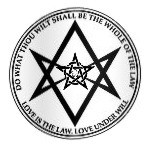
BACK TO LIBRARY

|